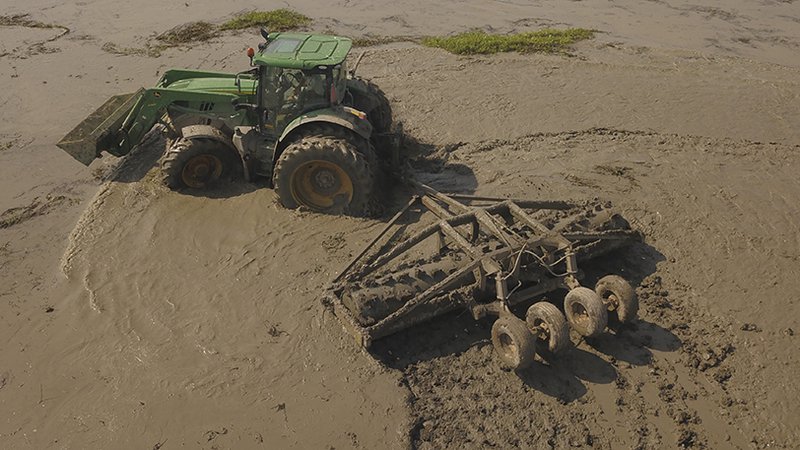Year-round Moist-Soil Work Focused on Disturbance
BY Jim Harris
ON 07-29-2019

July 29, 2019
Jim Harris
Managing Editor Arkansas Wildlife Magazine
DES ARC – There has been a disturbance going on not far from here, but hardly anyone has noticed. All anyone will ever notice, if the disturbance continues as planned, is a great feeding ground for migrating waterfowl later this fall.
AGFC biologists have been disturbing the soil in parts of Steve N. Wilson Raft Creek Bottoms Wildlife Management Area. The reason for this is to help native seeds in the soil flourish in the growing season in the AGFC’s moist-soil units. These areas are growing smartweed, sedge and millet, which ducks will thrive on when they pass through Arkansas this winter.
However, because the White River has been backed up for much of spring and summer, some of these areas are a little more than “moist” – some are under nearly 2 feet of water, which holds back a lot of growth. Until recently, some places were under 5 feet of water. When prepping moist-soil units to be at their best when waterfowl arrive, AGFC biologists like Jason “Buck” Jackson and Jacob Bokker give those fields some assistance. In this case, they “disturb” the soil with a tractor and heavy stubble roller that simulates disking, only it’s done with water covering last year’s vegetation residue and it’s far more efficient than waiting to disk the field when it dries. This soil disturbance, though, can only be done in up to 10 inches of water, says Jackson, the AGFC’s statewide Wetlands Program Coordinator.
If all goes according to plan, as water recedes off the fields, they’ll be loaded with a smorgasbord of goodness for ducks.
“A moist-soil habitat is a diverse community of (annual) plants that really produces a high volume of seeds as well as invertebrates,” Jackson said. “It’s a true buffet, compared to the (agriculture) fields. An ag field is basically loaded with candy bars, where moist-soil habitat is a 100-foot buffet, fully loaded. A good moist-soil unit will provide the macronutrients, the proteins and amino acids in a digestible food source for the ducks. A field of rice is basically a bunch of Snickers bars lying around.”
The AGFC has 208 moist-soil units totalling about 8,900 acres around Arkansas, Jackson said.
The nutrients ducks get from eating smartweed, millet and other heavy-seeded annual plants (sprangletop, toothcup and panic grasses), along with the invertebrates they will find while dining in the moist-soil units in fall, winter and spring, will be essential for survival, pairing and migration as well as for their breeding and egg-laying next spring in the northern nesting grounds of the Dakotas and Canada. Jackson said research shows a diverse moist-soil unit provides the necessary proteins and other nutrients that, for instance, help a male mallard through its secondary molting process (re: developing that gorgeous and distinctive green head) to boost its attractiveness to the female.
Jackson boiled it down fairly plainly, with some science behind it: “You know, you can survive and get a girlfriend by eating Snickers all the time, but you’re not going to be in your best shape … the proteins and the macronutrients are important for drakes in that way for attracting hens and for those hens preparing for nesting. There is really a lot of science to it for the importance of having a well-balanced diet.”
Jackson says the preparation for the AGFC’s moist-soil units, many of which offer public hunting during the duck season, is a year-round effort, beginning with soil disturbance in February and a slow drawdown of water in March, leaving enough moisture when the temperature is just right for plant germination.
For native moist-soil plants in a typical year, the crew would pull soil samples and correct the soil if needed, irrigate as needed, apply pesticides if called for, manipulate the crop of natives post-growing season in October, apply more pesticides if needed in October to control some perennials and add water to the sites. “If the site needed to be reset with a heavy disking, we would deep disk, correct the soil, finish tilling, plant, irrigate, add nitrogen after millet development and apply pesticides for undesirables,” Jackson said.
But then, after thinking it over, Jackson suggests it may really be a 3-4 year effort. The seed and other organics that have stayed within the system, and the growth in place well in advance of this year’s work, are what make a moist-soil unit so desirable – both to ducks on the migratory trip through the state, and to hunters seeking to harvest ducks during the season.
Also, soil disturbance doesn’t only occur when water has topped out over the plants. There are situations such as at Ed Gordon Point Remove WMA in the Arkansas River Valley where the soil, seeds and plants have become so compacted, a tractor and ripper have to break things up to promote better growth. Deep tilling will bring new seeds to the surface, keep the organics in the system, “and I have a healthier moist-soil unit,” Jackson said.
The AGFC’s moist-soil units are, as Jackson describes, the “bottom of the hill, down in the lowlands. That’s where this community of native, natural smartweed and millet first started out. It’s easier for us to propagate this than to develop cultivated fields of a single species. With the flood events like we’ve had the past three years, most cultivated species won’t live through that. But the moist-soil community like at Bell Slough (WMA) has been underwater for 3-4 weeks and there is some good stuff living there.”
The smartweed, of which there are two varieties of “desirable” plants the AGFC wants to grow, and the sedges, millet and other grasses have the genetics to handle a flood event. Bidens (aka beggarticks) produce a significant amount of protein compared to other food sources, Jackson said. Then there are panic grasses, of which about 15 species, Jackson said, like to grow, usually starting Aug. 1.
“That’s the way we stock the food up,” he said. “For instance at Halowell (Reservoir, in the George H. Dunklin Bayou Meto WMA) in past years, we have pulled off three crops there, all native. Some fertilizer and some irrigation was all it took.”
When the native crops fail to come through, he said, they will plant a cover crop of Japanese millet. At Bell Slough where there are two units, for instance, the team recently supplementally planted some Japanese millet with the good toothcup, barnyard grass and smartweed in the east unit. The west unit will get a deep disking and likely a cover crop, Jackson said.
By the end of May or first of June, when the moist-soil fields have met Jackson’s strict criteria of enough good plants, he can apply herbicide to weed out “undesirable” plants. Or, if there aren’t enough good plants, they will supplement it with an additional native weed or go in and disk the unit, he said. The biologists also are pulling soil samples, checking pH levels and macronutrient levels, correcting any deficiencies during this time. “The soil must be balanced properly or this is all for naught,” he said.
Jackson says he has one AGFC employee working directly for him, while area staff in the various regions of the state help deliver moist-soil management objectives. “We probably have close to 30 folks helping with this, helping make sure plans are executed,” he said. “Over the years, we’ve gotten better and better as far as having better equipment and being able to execute those plans. Equipment we purchased in 2012 helped us get away from contractors for everything we do. Those same contractors had their own farms, and we were put down the list. We can move at a more efficient time frame for our native crops now that we can do it ourselves.”
The AGFC also calls upon flying service vendors for work on the units, from aerial sowing of millet to chemical spraying for such enemies to a moist-soil unit as the Army worm. Jackson added, “You’ve got have many tools in your pocket to get this to work.”
Recent News

Arkansas Wildlife Weekly Fishing Report
Jul. 10, 2025

Lonoke aquaculturist named to AGFC
Jul. 10, 2025
Subscribe to Our Weekly Newsletter E-mails
Don’t miss another issue. Sign up now to receive the AGFC Wildlife Weekly Newsletter in your mailbox every Wednesday afternoon (Waterfowl Reports are published weekly during waterfowl season and periodically outside the season). Fishing Reports arrive on Thursdays. Fill in the following fields and hit submit. Thanks, and welcome!
